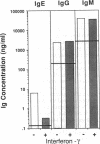Abstract
The cytokine interleukin 4 (IL-4) has been shown to induce lipopolysaccharide-activated murine B cells to differentiate into IgE-secreting cells and to stimulate IgE secretion by cultured human peripheral blood lymphoid cells. It is unclear, however, whether this effect of IL-4 on human peripheral blood lymphoid cells is a direct effect on the B cell because IL-4 can stimulate T cells and monocytes as well as B cells and does not induce purified human B cells to secrete immunoglobulin. To investigate this issue we studied the ability of IL-4 to induce IgE secretion by purified human B cells (93-96% CD20+, less than 1% CD3+) that were cultured with Epstein-Barr virus (EBV). Although B cells cultured with IL-4 alone did not secrete Ig and B cells cultured with EBV alone secreted IgM, IgG, and IgA but less than 150 pg of IgE per ml, the combination of EBV and IL-4 induced an IgE response that ranged from 11.4 to 40.3 ng/ml of culture supernatant after 26 days of culture. While IL-4 also enhanced IgM, IgG, and IgA secretion, as well as proliferation by EBV-infected B cells, these effects were less pronounced, occurred earlier during culture, and required a lower concentration of IL-4 than did the stimulation of IgE secretion. Furthermore, interferon gamma at 10 units per ml was found to inhibit IL-4/EBV-induced IgE secretion without inhibiting the other stimulatory effects of IL-4. We conclude that (i) IL-4 and interferon gamma can act directly on polyclonally activated human B cells to respectively stimulate and suppress IgE secretion and (ii) IL-4, in addition to its specific effect on IgE secretion, has a general stimulatory effect on the growth and differentiation of EBV-infected human B cells.
Full text
PDF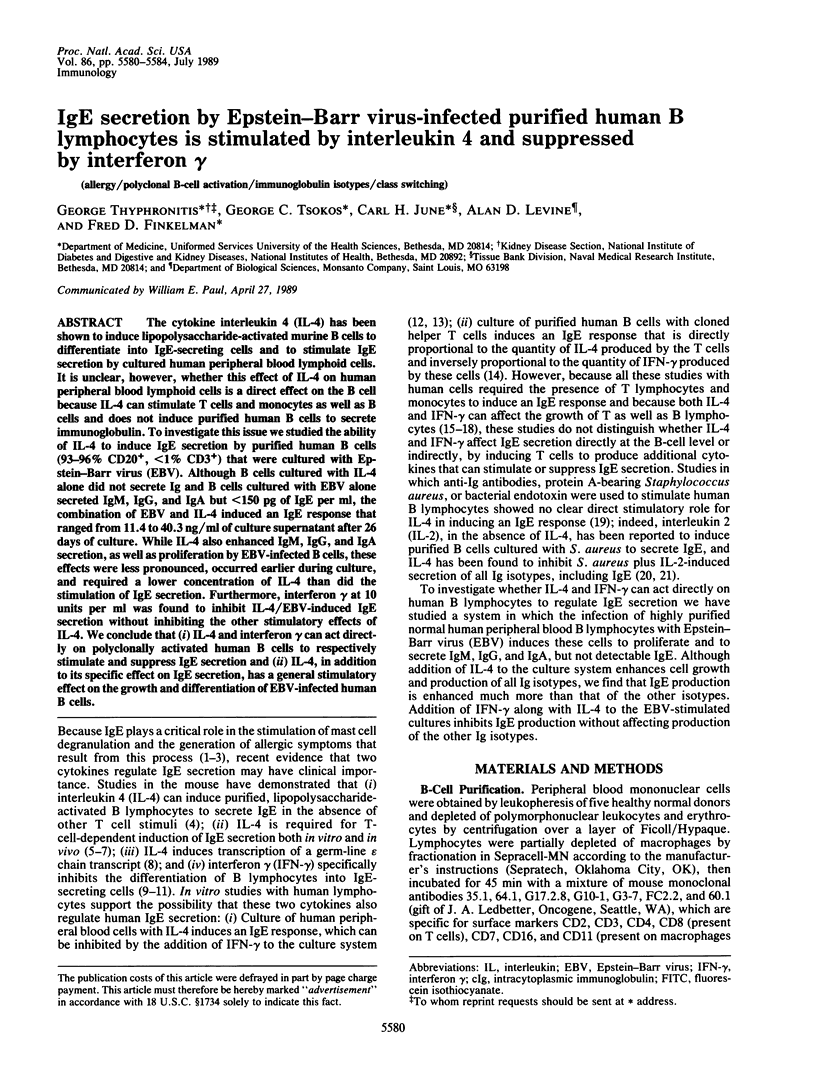
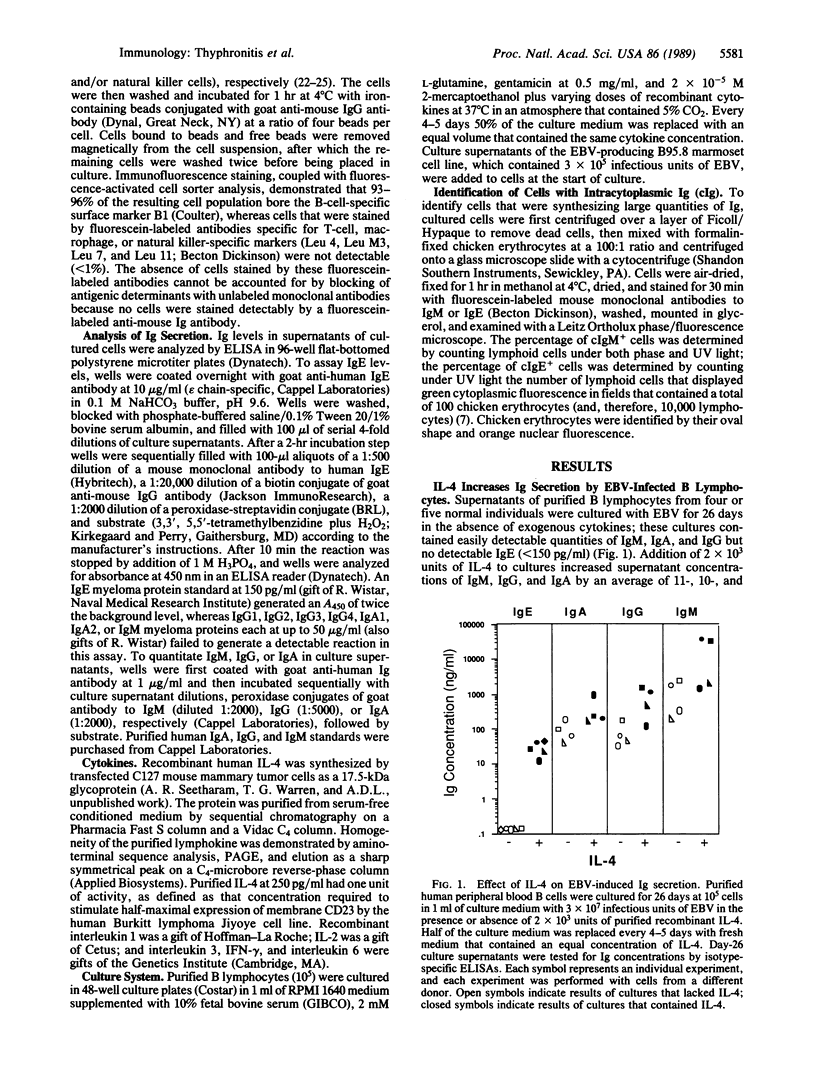
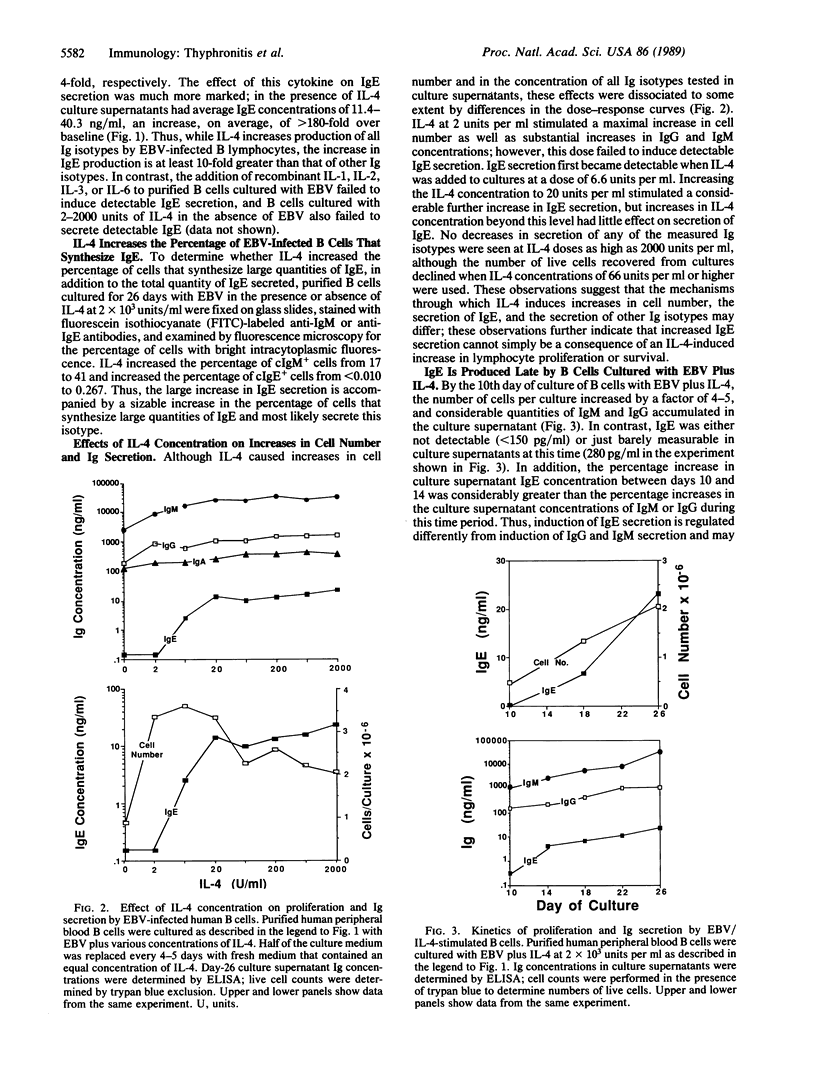
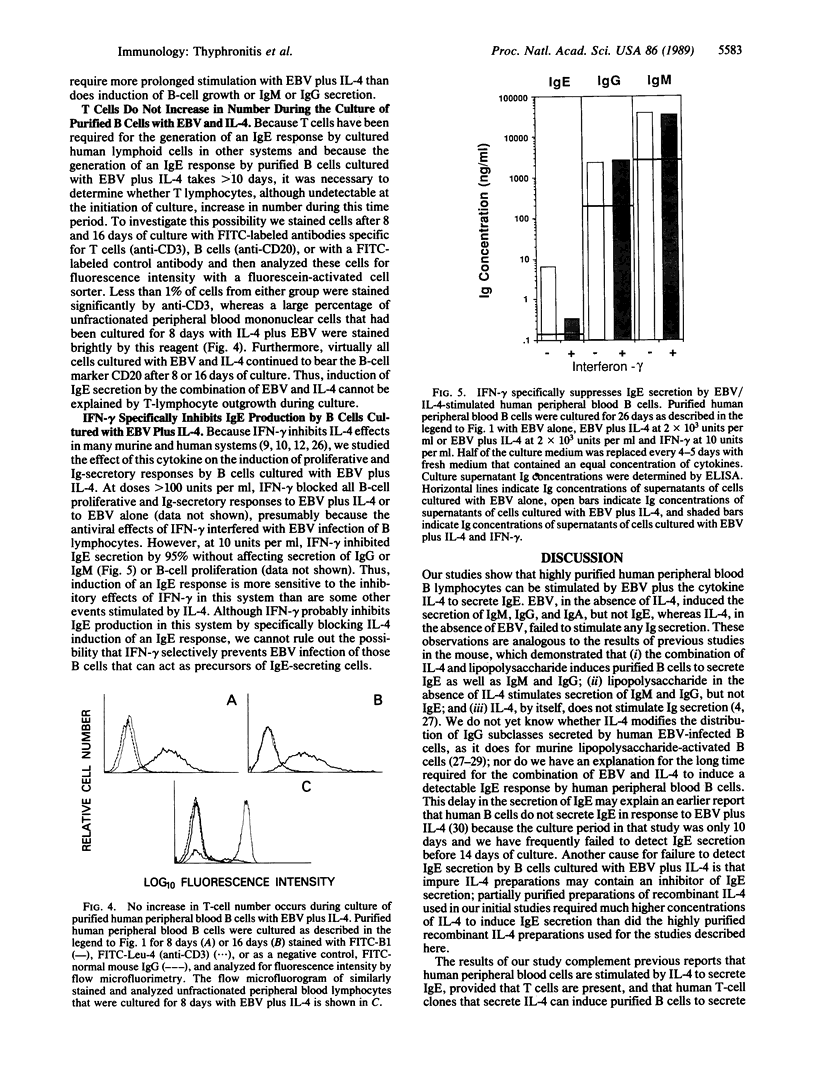
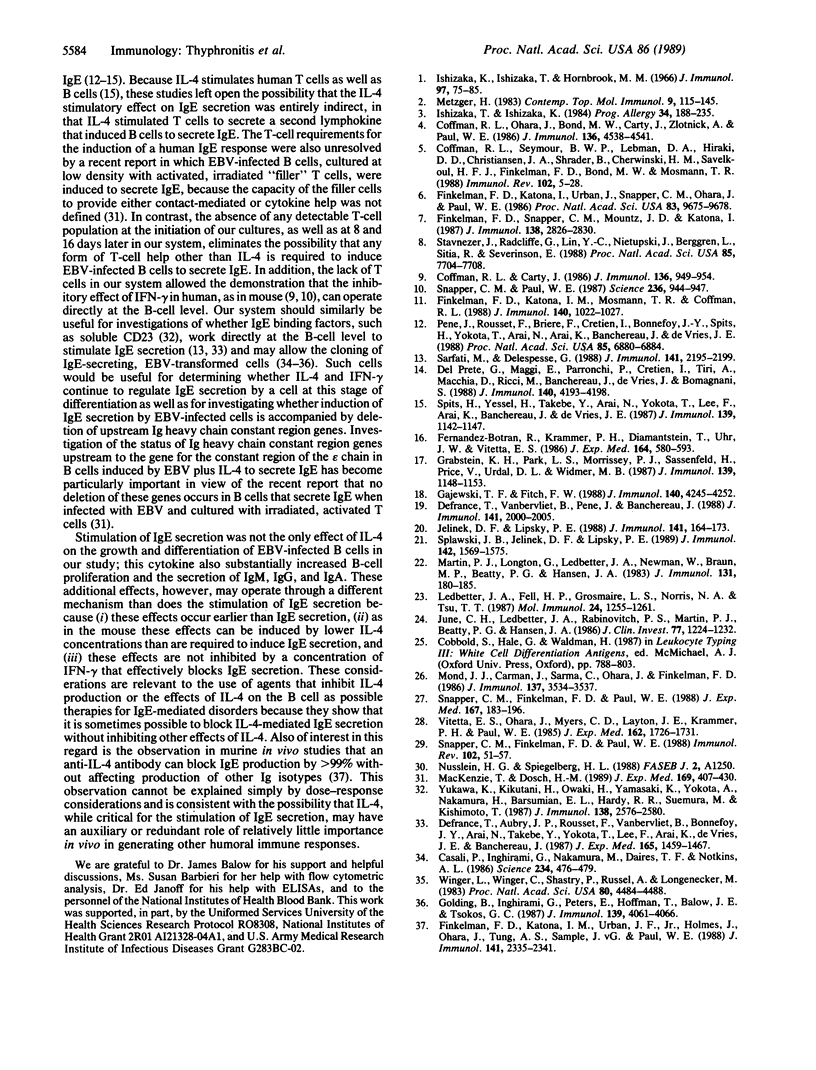
Images in this article
Selected References
These references are in PubMed. This may not be the complete list of references from this article.
- Casali P., Inghirami G., Nakamura M., Davies T. F., Notkins A. L. Human monoclonals from antigen-specific selection of B lymphocytes and transformation by EBV. Science. 1986 Oct 24;234(4775):476–479. doi: 10.1126/science.3020687. [DOI] [PubMed] [Google Scholar]
- Coffman R. L., Carty J. A T cell activity that enhances polyclonal IgE production and its inhibition by interferon-gamma. J Immunol. 1986 Feb 1;136(3):949–954. [PubMed] [Google Scholar]
- Coffman R. L., Ohara J., Bond M. W., Carty J., Zlotnik A., Paul W. E. B cell stimulatory factor-1 enhances the IgE response of lipopolysaccharide-activated B cells. J Immunol. 1986 Jun 15;136(12):4538–4541. [PubMed] [Google Scholar]
- Coffman R. L., Seymour B. W., Lebman D. A., Hiraki D. D., Christiansen J. A., Shrader B., Cherwinski H. M., Savelkoul H. F., Finkelman F. D., Bond M. W. The role of helper T cell products in mouse B cell differentiation and isotype regulation. Immunol Rev. 1988 Feb;102:5–28. doi: 10.1111/j.1600-065x.1988.tb00739.x. [DOI] [PubMed] [Google Scholar]
- Defrance T., Aubry J. P., Rousset F., Vanbervliet B., Bonnefoy J. Y., Arai N., Takebe Y., Yokota T., Lee F., Arai K. Human recombinant interleukin 4 induces Fc epsilon receptors (CD23) on normal human B lymphocytes. J Exp Med. 1987 Jun 1;165(6):1459–1467. doi: 10.1084/jem.165.6.1459. [DOI] [PMC free article] [PubMed] [Google Scholar]
- Defrance T., Vanbervliet B., Pène J., Banchereau J. Human recombinant IL-4 induces activated B lymphocytes to produce IgG and IgM. J Immunol. 1988 Sep 15;141(6):2000–2005. [PubMed] [Google Scholar]
- Del Prete G., Maggi E., Parronchi P., Chrétien I., Tiri A., Macchia D., Ricci M., Banchereau J., De Vries J., Romagnani S. IL-4 is an essential factor for the IgE synthesis induced in vitro by human T cell clones and their supernatants. J Immunol. 1988 Jun 15;140(12):4193–4198. [PubMed] [Google Scholar]
- Fernandez-Botran R., Krammer P. H., Diamantstein T., Uhr J. W., Vitetta E. S. B cell-stimulatory factor 1 (BSF-1) promotes growth of helper T cell lines. J Exp Med. 1986 Aug 1;164(2):580–593. doi: 10.1084/jem.164.2.580. [DOI] [PMC free article] [PubMed] [Google Scholar]
- Finkelman F. D., Katona I. M., Mosmann T. R., Coffman R. L. IFN-gamma regulates the isotypes of Ig secreted during in vivo humoral immune responses. J Immunol. 1988 Feb 15;140(4):1022–1027. [PubMed] [Google Scholar]
- Finkelman F. D., Katona I. M., Urban J. F., Jr, Holmes J., Ohara J., Tung A. S., Sample J. V., Paul W. E. IL-4 is required to generate and sustain in vivo IgE responses. J Immunol. 1988 Oct 1;141(7):2335–2341. [PubMed] [Google Scholar]
- Finkelman F. D., Katona I. M., Urban J. F., Jr, Snapper C. M., Ohara J., Paul W. E. Suppression of in vivo polyclonal IgE responses by monoclonal antibody to the lymphokine B-cell stimulatory factor 1. Proc Natl Acad Sci U S A. 1986 Dec;83(24):9675–9678. doi: 10.1073/pnas.83.24.9675. [DOI] [PMC free article] [PubMed] [Google Scholar]
- Finkelman F. D., Snapper C. M., Mountz J. D., Katona I. M. Polyclonal activation of the murine immune system by a goat antibody to mouse IgD. IX. Induction of a polyclonal IgE response. J Immunol. 1987 May 1;138(9):2826–2830. [PubMed] [Google Scholar]
- Gajewski T. F., Fitch F. W. Anti-proliferative effect of IFN-gamma in immune regulation. I. IFN-gamma inhibits the proliferation of Th2 but not Th1 murine helper T lymphocyte clones. J Immunol. 1988 Jun 15;140(12):4245–4252. [PubMed] [Google Scholar]
- Golding B., Inghirami G., Peters E., Hoffman T., Balow J. E., Tsokos G. C. In vitro generated human monoclonal trinitrophenyl-specific B cell lines. Evidence that human and murine anti-trinitrophenyl monoclonal antibodies cross-react with Escherichia coli beta-galactosidase. J Immunol. 1987 Dec 15;139(12):4061–4066. [PubMed] [Google Scholar]
- Grabstein K. H., Park L. S., Morrissey P. J., Sassenfeld H., Price V., Urdal D. L., Widmer M. B. Regulation of murine T cell proliferation by B cell stimulatory factor-1. J Immunol. 1987 Aug 15;139(4):1148–1153. [PubMed] [Google Scholar]
- Ishizaka K., Ishizaka T., Hornbrook M. M. Physico-chemical properties of human reaginic antibody. IV. Presence of a unique immunoglobulin as a carrier of reaginic activity. J Immunol. 1966 Jul;97(1):75–85. [PubMed] [Google Scholar]
- Ishizaka T., Ishizaka K. Activation of mast cells for mediator release through IgE receptors. Prog Allergy. 1984;34:188–235. [PubMed] [Google Scholar]
- Jelinek D. F., Lipsky P. E. Inhibitory influence of IL-4 on human B cell responsiveness. J Immunol. 1988 Jul 1;141(1):164–173. [PubMed] [Google Scholar]
- June C. H., Ledbetter J. A., Rabinovitch P. S., Martin P. J., Beatty P. G., Hansen J. A. Distinct patterns of transmembrane calcium flux and intracellular calcium mobilization after differentiation antigen cluster 2 (E rosette receptor) or 3 (T3) stimulation of human lymphocytes. J Clin Invest. 1986 Apr;77(4):1224–1232. doi: 10.1172/JCI112425. [DOI] [PMC free article] [PubMed] [Google Scholar]
- Ledbetter J. A., Fell H. P., Grosmaire L. S., Norris N. A., Tsu T. T. An immunoglobulin light chain dimer with CD4 antigen specificity. Mol Immunol. 1987 Dec;24(12):1255–1261. doi: 10.1016/0161-5890(87)90119-2. [DOI] [PubMed] [Google Scholar]
- MacKenzie T., Dosch H. M. Clonal and molecular characteristics of the human IgE-committed B cell subset. J Exp Med. 1989 Feb 1;169(2):407–430. doi: 10.1084/jem.169.2.407. [DOI] [PMC free article] [PubMed] [Google Scholar]
- Martin P. J., Longton G., Ledbetter J. A., Newman W., Braun M. P., Beatty P. G., Hansen J. A. Identification and functional characterization of two distinct epitopes on the human T cell surface protein Tp50. J Immunol. 1983 Jul;131(1):180–185. [PubMed] [Google Scholar]
- Metzger H. The receptor on mast cells and related cells with high affinity for IgE. Contemp Top Mol Immunol. 1983;9:115–145. doi: 10.1007/978-1-4684-4517-6_4. [DOI] [PubMed] [Google Scholar]
- Mond J. J., Carman J., Sarma C., Ohara J., Finkelman F. D. Interferon-gamma suppresses B cell stimulation factor (BSF-1) induction of class II MHC determinants on B cells. J Immunol. 1986 Dec 1;137(11):3534–3537. [PubMed] [Google Scholar]
- Pène J., Rousset F., Brière F., Chrétien I., Bonnefoy J. Y., Spits H., Yokota T., Arai N., Arai K., Banchereau J. IgE production by normal human lymphocytes is induced by interleukin 4 and suppressed by interferons gamma and alpha and prostaglandin E2. Proc Natl Acad Sci U S A. 1988 Sep;85(18):6880–6884. doi: 10.1073/pnas.85.18.6880. [DOI] [PMC free article] [PubMed] [Google Scholar]
- Sarfati M., Delespesse G. Possible role of human lymphocyte receptor for IgE (CD23) or its soluble fragments in the in vitro synthesis of human IgE. J Immunol. 1988 Oct 1;141(7):2195–2199. [PubMed] [Google Scholar]
- Snapper C. M., Finkelman F. D., Paul W. E. Differential regulation of IgG1 and IgE synthesis by interleukin 4. J Exp Med. 1988 Jan 1;167(1):183–196. doi: 10.1084/jem.167.1.183. [DOI] [PMC free article] [PubMed] [Google Scholar]
- Snapper C. M., Finkelman F. D., Paul W. E. Regulation of IgG1 and IgE production by interleukin 4. Immunol Rev. 1988 Feb;102:51–75. doi: 10.1111/j.1600-065x.1988.tb00741.x. [DOI] [PubMed] [Google Scholar]
- Snapper C. M., Paul W. E. Interferon-gamma and B cell stimulatory factor-1 reciprocally regulate Ig isotype production. Science. 1987 May 22;236(4804):944–947. doi: 10.1126/science.3107127. [DOI] [PubMed] [Google Scholar]
- Spits H., Yssel H., Takebe Y., Arai N., Yokota T., Lee F., Arai K., Banchereau J., de Vries J. E. Recombinant interleukin 4 promotes the growth of human T cells. J Immunol. 1987 Aug 15;139(4):1142–1147. [PubMed] [Google Scholar]
- Splawski J. B., Jelinek D. F., Lipsky P. E. Immunomodulatory role of IL-4 on the secretion of Ig by human B cells. J Immunol. 1989 Mar 1;142(5):1569–1575. [PubMed] [Google Scholar]
- Stavnezer J., Radcliffe G., Lin Y. C., Nietupski J., Berggren L., Sitia R., Severinson E. Immunoglobulin heavy-chain switching may be directed by prior induction of transcripts from constant-region genes. Proc Natl Acad Sci U S A. 1988 Oct;85(20):7704–7708. doi: 10.1073/pnas.85.20.7704. [DOI] [PMC free article] [PubMed] [Google Scholar]
- Vitetta E. S., Ohara J., Myers C. D., Layton J. E., Krammer P. H., Paul W. E. Serological, biochemical, and functional identity of B cell-stimulatory factor 1 and B cell differentiation factor for IgG1. J Exp Med. 1985 Nov 1;162(5):1726–1731. doi: 10.1084/jem.162.5.1726. [DOI] [PMC free article] [PubMed] [Google Scholar]
- Winger L., Winger C., Shastry P., Russell A., Longenecker M. Efficient generation in vitro, from human peripheral blood cells, of monoclonal Epstein-Barr virus transformants producing specific antibody to a variety of antigens without prior deliberate immunization. Proc Natl Acad Sci U S A. 1983 Jul;80(14):4484–4488. doi: 10.1073/pnas.80.14.4484. [DOI] [PMC free article] [PubMed] [Google Scholar]
- Yukawa K., Kikutani H., Owaki H., Yamasaki K., Yokota A., Nakamura H., Barsumian E. L., Hardy R. R., Suemura M., Kishimoto T. A B cell-specific differentiation antigen, CD23, is a receptor for IgE (Fc epsilon R) on lymphocytes. J Immunol. 1987 Apr 15;138(8):2576–2580. [PubMed] [Google Scholar]



